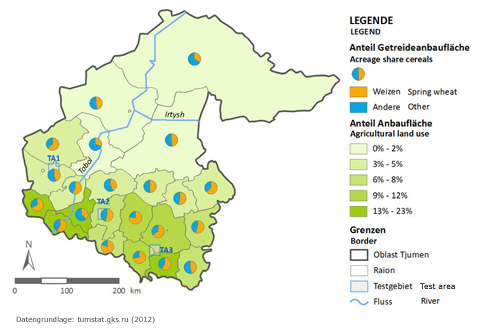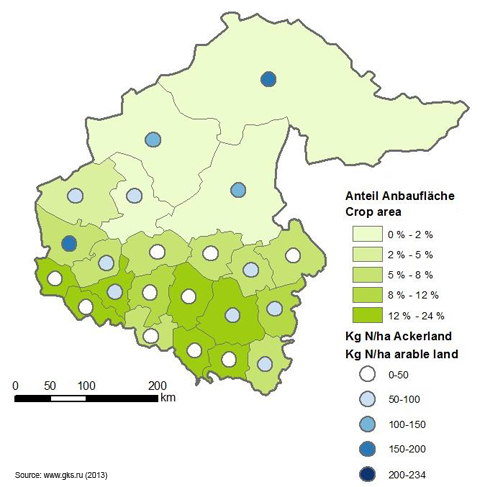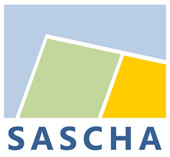Subproject 500
SP 500 - Sustainable agricultural management and adaptation strategies to climate change
Introduction - Objectives - Methods & Preliminary Results
Introduction
The southern part of the Oblast Tyumen is part of the forest steppe zone, where climatic conditions allow intensive farming especially for production of spring wheat. Arable land use concentrates on humus-rich Chernozems and is partially characterized by a low input of production means and moderate yields. The challenges of climate change and the expected intensification of land use for food production in Western Siberia require the development of strategies for sustainable agriculture. The aims of these strategies must protect both, the productivity of agricultural land and natural resources (soil, water, biodiversity).

Objectives
SP 500 aims to develop strategies for a sustainable agriculture and adaptation strategies to current climate change in the Oblast Tyumen. The structure and form of agricultural land use will be analyzed and effects of different forms of land use on productivity, carbon stocks, material flow and biodiversity will be investigated. Long-term experiments on different tillage variants will be analyzed in close cooperation with the Russian partners and concepts for an optimized management of material flow at regional level will be worked out. At farm level alternative production systems to usual methods are tested in close collaboration with a large local enterprise. Based on these results, concepts for the improvement of sustainable land-use practices shall be implemented.

Methods & Preliminary Results
SP 510 - Analysis and optimization of sustainable agricultural management practices on farm level
- Analysis of agricultural structures in Tyumen region
- Installation of large scale field trials on spring wheat production technology (tillage and seeding parameters)
- Test cultivation of soy beans in Western Siberia
- Improvement of strategies for sustainable agricultural land use on farm level
The spatial distribution of agricultural structures shows an increasing production intensity from north to south. Spring wheat is the most dominant crop, especially in intensively used areas. Crop production is usually limited by water supply in this region. During the last years there were more frequently crop failures because of extreme weather events.
Field trials were installed on the agricultural enterprise „ZAO Plemzavod Yubileyny“ in Ishim to identify sustainable crop production systems, which are able to provide long term stable yields, even under changing climate conditions. For three years different combinations of tillage and seeding operations are tested particularly with regard to water use efficiency. On 10 ha spring wheat is cultivated in completely randomized block design with 3 replications to demonstrate the potential of modern and precise technology compared to common practice.

SP 520 – Biodiversity and carbon stocks of arable land at different land-use intensities
Analysis of diversity and species composition of plant species on differently used agricultural fields and on abandoned land
Estimation of carbon stocks in soils of arable fields and abandoned fields of different age in selected test areas of the Oblast Tyumen
Development of an indicator system for the evaluation of agricultural land and ex-arable concerning their potential for agricultural production, carbon sequestration and biodiversity

First results showed that despite the low cropping intensity floral biodiversity was low and comparable with conditions known from regions with high input farming. More detailed analyses following the field work 2013 will reveal differences along the land-use and climatic gradient. Moreover we will quantify the contribution of arable weeds to total floristic diversity on landscape level.
Remarkably, croplands harvested species rich grasshopper assemblages, which even reproduced on the fields. This is a surprising result because croplands of temperate regions are not known as grasshopper habitats. Usually the disturbance through ploughing and other farming operations is so high that grasshopper cannot find suitable egg-laying sites in croplands.

SP 530 - Regional material-flow management for nutrients and organic carbon
- Analysis of long-term field experiments on effects of different tillage and fertilization variants in respect to carbon and nutrient balances and soil quality
- Modelling of organic carbon in arable fields to predict SOC stocks under changing climatic conditions
- Comparison of soil characteristics of arable fields and non-arable sites to quantify changes due to arable land use in the topsoil
- Regional analysis of livestock breeding and arable farming by-products for organic fertilization
- Modeling of material-flow management at regional level
Initial studies of arable and non-arable land have shown that the soil structure significantly changes due to agricultural land use. Ploughing leads to strong clods formation. The granular content decreases, subangular blocky and angular blocky peds increase due to agricultural use. The bulk density of arable fields is higher than those of the non-arable sites.
For material flow management the nutrient accumulation per hectare of arable land from manure per district was calculated for the year 2011 (figure below). Remarkable are the high levels of nitrogen and livestock units in Tyumen district. 93% of the total poultry production in the province takes place in Tyumen district. Three large poultry farms and smaller farms kept in 2011, over 7 million animals. Also in the most northern district Uvat the N-accumulation due to manure with 226 kg N/ha of arable land is very high. The southern districts are dominated by plant production and have a rather low livestock density.
Contact
Contact
Prof. Dr. Dieter Trautz (SP 510) / Kathrin Kiehl (SP 520)
Hochschule Osnabrück
Fakultät Agrarwissenschaften und Landschaftsarchitektur
Postfach 1940
D- 49009 Osnabrück
Tel. : +49 (0) 541 969 5058 (Trautz) / +49 (0) 541 969 5042 (Kiehl)
Fax: +49 (0) 541 969 5205 (Trautz) / +49 (0) 541 969 5170 (Kiehl)
E-Mail: d.trautz@hs-osnabrueck.de / k.kiehl@hs-osnabrueck.de
Web (Trautz):http://www.al.hs-osnabrueck.de/9324+M58495982e7c.html
Web (Kiehl): http://www.al.hs-osnabrueck.de/kiehl.html
Prof. Dr. Gabriele Broll (SP 530)
Universität Osnabrück Institut für Geographie
Seminarstraße 19 a/b
D- 49074 Osnabrück
Tel. : +49 (0) 541 541 969 4073
Fax: +49 (0) 541 969 4333
E-Mail: gabriele.broll@uni-osnabrueck.de
Web: http://www.geographie.uni-osnabrueck.de/index.php?n=Mitarbeiter.Broll











